
Day 29: Coasting Along Through Maine
April 17, 2021
Day 27: Cruising Through Connecticut… With a Stop at Sandy Hook
April 15, 2021Most recently updated on March 28, 2024
Driven on July 20, 2023
Originally posted on April 16, 2021
The most crowded day of the year in Salem, Massachusetts, is Halloween.
There’s a good reason for that.
The city is best known for the 11 months of persecution that happened 332 years ago in which 20 people believed to be witches were put to death.
Today, Salem embraces that legacy in a number of ways. There are museums that document the history of the trials as well as souvenir shops that cater to the tourist crowd. Schools have witch-related names and mascots. Even the police cars have logos with witches.
I have a more personal connection.
Two of my great aunts were among those executed in 1692. One of them is a main character in the play “The Crucible.”
Salem is where we will end today’s journey, but before we get here we need to zig-zag across this state where our nation’s revolution against Great Britain began.
To start the day, we head north on Interstate 95 out of Providence, Rhode Island. We pass through the town of Pawtucket and in 10 minutes we’ve crossed over the border into Massachusetts.
The Bay State is 44th in size with its 10,554 square miles, slightly smaller than Hawaii.

However, it’s the most populous New England States as well as 16th in population overall with slightly more than 7 million residents, about two-thirds of whom live in the greater Boston area. That congregation helps ranks Massachusetts as the 3rd most densely populated state, behind New Jersey and Rhode Island.
Its $96,000 median annual household income ranks among the highest for states and it has a $15.00 minimum wage, one of the highest in the nation.
Massachusetts is the site of Plymouth, where the Pilgrims landed in 1620. Historians say the state is where the American Revolution really started. It has also helped shape American politics from the Adams to the Kennedy families. In 2004, it became the first state to recognize same-sex marriages.
The region’s early economy depended on agriculture and fishing. It became a manufacturing center during the Industrial Revolution. We’ll see a lot of that history during our journey.
Today, the state is now a leader in biotechnology, engineering, finance and maritime trade. It’s also home to Harvard University and the Massachusetts Institute of Technology (MIT).
——————————————-
It’s only another 10 minutes on I-95 before we reach our first historic Massachusetts locale.
Attleboro is a town that has been known for 200 years for its jewelry.
This region was originally inhabited by the Pokanoket tribe. The first English settlers arrived in 1634.
Agriculture wasn’t a viable industry here due to the poor soil, so manufacturing quickly became a mainstay. In 1780, a brass working forge was set up by a man known as “The Frenchman.” Among other things, it made buttons for soldiers’ uniforms. Textile manufacturers began appearing in the early 1800s.
The first jewelry shop opened in 1807. By 1855, there were nearly 25 jewelry and button manufacturers in town. Costume jewelry became common because gold was too expensive and fragile.
By 1900, half of the Attleboro’s residents were employed in the jewelry industry. The city eventually became known as the Jewelry Capital of the World, driven by the skills and ingenuity of immigrants who had worked in the jewelry business in Europe.
In 1907, S. O. Bigney & Company operated the largest jewelry factory in the country. In 1913, the L. G. Balfour Company formed and became the city’s second largest employer after it started making class rings. In 1964, there were 13,000 people working in 163 jewelry plants in Attleboro.
Balfour moved its operations to Texas in 1996 and its old factory was converted into a riverfront park. However, many jewelry manufacturers remain in town.
The history of the city’s jewelry industry is on display at the Attleboro Area Industrial Museum.
The economy today remains driven by the jewelry industry as well as electric components, plastics and other products.
As in other cities, there has been an environmental price for all this industry.
There have been concerns over cancer clusters from the Shpack Landfill, a 9-acre Superfund site on the edge of town that operated from 1946 to the 1970s. The landfill accepted radioactive waste and other hazardous materials from jewelry plants as well as Metals and Control Inc., a complex that manufactured uranium fuel for nuclear reactors.
A 2011 state report concluded there was no abnormal rise in cancer cases in a one-mile radius from the former landfill.
However, that did not stop legal action from being pursued.
In 2008, a lawsuit was filed by two women who used to live in the area and later developed thyroid cancer. In 2016, a lawsuit was filed by two dozen former workers at the Metals and Control plant.
A federal cleanup of the site was finished in 2014. It included disposing of 50,000 cubic yards of materials and 27,000 tons of waste. Routine monitoring of the site was completed in 2020. Texas Instruments, which merged with Metals and Control Inc. in 1959, paid for $15 million of the cleanup.
Attleboro is also home to the Women at Work Museum, which honors the achievements of women throughout history. It also offers education programs that promote leadership and economic independence as well as math and science education.
In the past two decades, the city of 46,000 residents has been attempting to revitalize the downtown area. In 2007, officials announced an urban renewal plan. A number of projects have fallen through, but a riverfront park development was completed in 2018. In June 2019, a plan was unveiled to build 119 apartments near the commuter rail station. In September 2021, a financing agreement was reached to move the project forward. Renaissance Station North is now one of a number of affordable housing projects in the downtown area.
Reading, Writing and Revolution
We continue north on Interstate 95, skirting the greater Boston metropolitan area.
This region immediately brings back memories of the 1986 Boston Marathon I ran with my college friend, Mark Shuman, who lived in the area at the time.
The marathon route begins in the small town of Hopkinton and follows a pretty straight northeasterly path into downtown Boston. It passes through other small towns such as Framingham as well as past Wellesley College and Boston College before it glides through neighborhoods such as Brookline.
One of the towns the competitors run through is Newton, a community of 86,000 people that sits just east of I-95 about a third of the way between Boston and Hopkinton.
The Nonantum tribe lived in the area before it was settled by Europeans in 1630. It was incorporated as a city in 1873, but today is known as a collection of 13 villages.

Boston Marathon runners brave the hills in Newton, Massachusetts. Photo by Women’s Running Magazine.
The early economy centered on milling and forge industries built to take advantage of the power of nearby waterfalls. Products included snuff, chocolate, glue and paper.
In 1902, the Stanley Motor Carriage Company was established here. The firm manufactured 14,000 Stanley Steamer automobiles between 1898 and 1924. About 600 are still around.
Newton began to develop into a commuter suburb as far back as 1834 when a railroad to Boston was built. The wealthy had estates here and rode the train into the big city. Eventually, streetcars and automobiles replaced the trains as the main mode of transportation.
Newton continues to be well off today with a median annual household income of $176,000 with a poverty rate of less than 5 percent. The median home price sits at $1.6 million.
The Fig Newton is actually named after the town. The cookie was first manufactured using a new double-funnel production technique near Newton in 1891. Today, the Fig Newton is made in Nabisco’s large Chicago factory.
However, Newton is best known for being one of the primary towns along the Boston Marathon. The city is the location of the series of four hills, including the infamous Heartbreak Hill, between miles 18 and 20 of the 26-mile race.
The marathon is usually run on the third Monday in April.
Newton has had a number of well-known actors who have lived here. Among them are Matt Damon, John Krasinski, Amy Poehler, Bette Davis, Jack Lemmon, Leonard Nimoy and Matt Le Blanc.
——————————————
A few miles north of Newton, we turn west on Highway 2 to reach the historic town of Concord.
The community of 18,000 residents is best known for its early Revolutionary War battles, but it also has a significant past connected to the world of literature.
For starters, Concord is the location of the famed Walden Pond.
Today, the 64-acre, 102-foot-deep lake is used by the public to swim, boat, fish and picnic. It has a main beach area with three buildings and a parking lot.
The pond was designated as a national historic landmark in 1962 and is part of the 335-acre Walden Pond State Reservation. It’s protected in part by the Walden Woods Project, an organization founded in 1990 by Eagles musician Don Henley.
It’s a popular place. In a typical year, the pond will get 600,000 visitors.

Walden Pond in Concord, Massachusetts, is now a popular swimming spot for families
In fact, a 2018 study concluded the pond was being contaminated by urine from swimmers. That wasn’t the case 200 years ago.
Then, Walden Pond area was a quiet forested region with a few scattered houses for people who preferred to live in the wilderness.
One of the people who owned land as well as a home here was the writer Ralph Waldo Emerson, who was best known for essays such as “Nature.”
Emerson was a mentor to author Henry David Thoreau. From 1845 to 1847, Thoreau lived in a 10-foot by 16-foot cabin he built at Walden Pond on land owned by Emerson.
Thoreau was reportedly inspired to do his two-year stint by former slave Zilpah White, who lived in a one-room house near the pond and spun flax into linen fibers.
He was also reportedly intrigued by Frederic Tudor, the “Ice King” who harvested ice every winter from Walden Pond and other Boston area lakes to export to the Caribbean, Europe and India.
Thoreau, however, did not completely live a life of solitude at the cabin. He did plant beans and other crops, but he also entertained guests frequently. The author was also known to walk the mile and a half to the village of Concord to spend time there.
After leaving the cabin, Thoreau returned to his life in Concord. Seven years later, he finished his classic “Walden: Or a Life in the Woods.” The 1854 book is credited with helping start the study of ecology as well as the conservation movement.
The Thoreau cabin is no longer there. The site, which is a 15-minute walk from the pond’s parking lot, is marked by some granite posts and a plaque. There is a replica of the cabin near the parking lot. Thoreau’s bed, chair, desk and other artifacts from the cabin are part of a vast collection of historical objects at the nearby Concord Museum.
Thoreau and Emerson were not the only well-known writers who lived in the area.
The Wayside was the home of authors Louisa May Alcott and Nathanial Hawthorne. Alcott also lived at the nearby Orchard House, where she wrote “Little Women” in 1868.
Alcott, Emerson and Thoreau are all buried in Sleepy Hollow Cemetery in Concord.
—————————————
The graves are near Minute Man National Historic Park.
The 900-acre preserve, created in 1959, commemorates the first military clash in the Revolutionary War.
The Battle of Lexington and Concord happened on April 19, 1775, when colonial commanders ordered 400 of their militia members to fire back at a contingent of 700 British soldiers at the North Bridge that spans the Concord River. The British were marching toward Concord to seize a cache of weapons.
Three British soldiers were killed and nine were wounded. Emerson dubbed it “the shot heard round the world” in his 1837 poem “Concord Hymn.”
After the initial fight, the British searched the town for four hours but failed to find the weapons. As they prepared to leave, 2,000 militia members descended on the area. The colonial rebels began firing at the British, who retreated hastily to Lexington. There they met up with a brigade of British reinforcements.
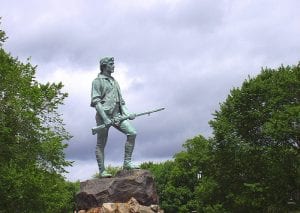
The Minuteman Statue in Lexington, Massachusetts. Photo by Wikimedia Commons.
The American militia chased the Redcoats back to the sea. When it was all over, 73 British troops were killed compared to 49 on the colonists’ side.
News of the battle spread throughout the colonies and emboldened revolutionaries, leading up to the following year’s Declaration of Independence.
The original North Bridge in Concord was dismantled in 1788 and replaced with a new span. Since then, the bridge has been replaced four other times, the latest renovation happening in 1956.
In the park, there is a Minute Man statue that was erected in 1875 on the battle’s centennial. There’s also the Obelisk statue, which is believed to be the nation’s first memorial to war casualties.
Leading out of the park is the 5-mile Battle Road Trail between Concord and Lexington. Along the route is the spot where Paul Revere was captured by the British during his midnight ride to warn people of the British’s arrival in Boston the day before the clash. There’s also Hartwell Tavern, a restored inn and home from the 1700s. It’s one of 11 original homes still existing from the time of the 1775 battle.
The Battle Road Trail ends in Lexington, the other half of the April 1775 battle.
This is where the British troops first encountered the colonists’ forces. They crossed each other’s path at the Common Green at sunrise where Captain John Parker told his militia: “Stand your ground. Don’t fire unless fired upon. But if they mean to have war, let it begin here.”
A shot was indeed fired by someone. Historians aren’t sure who. A battle ensued with eight militia men killed and only one British soldier injured. The Redcoats marched to Concord from here.
Today, the community remembers this clash at the Lexington Battle Green, which is a national historic landmark. This is the site where the British and colonist forces exchanged gunfire.
The site contains a Minuteman Statue, which was unveiled on April 19, 1900 on the 125th anniversary of the battle. It’s a depiction of a colonial farmer with a musket across his thigh.
There’s also the Revolutionary Monument, a granite obelisk that was erected in 1799.
The Hancock-Clarke House, which was built around 1698, documents the town’s involvement in the Revolutionary War. It also contains furnishings and paintings from that era.
There’s also the Old Burying Ground with headstones dating back to 1690. The graves include those of Revolutionary War as well as Civil War soldiers.
Although the 1775 skirmish is for what Lexington is best known, there’s a lot more to the city’s history.
The community was settled in 1640 and incorporated as a town in 1713.
Initially, this was a farming community that provided Boston with much of its produce. As the Industrial Revolution dawned, several mills were established. The railroad arrived in 1846 and spurred the economy even more.
In the 1960s and 1970s, Lexington was one of the communities along Route 128 that benefitted from the technology boom. In this region, it was spurred by the proximity of Harvard University and the Massachusetts Institute of Technology.
Today, the town still maintains a strong manufacturing sector to go along with its high-tech industry.
The economic balance seems to have paid off in this city of 35,000, which is 57 percent white and 31 percent Asian. The median annual household income is $206,000 with a poverty rate of only 4 percent. The average price of a home is $1.4 million.
Since 1966, Lexington has been one of the 37 school districts participating in the METCO program, a voluntary busing program that transports lower income students from Boston into wealthier communities to provide these children with higher quality education.
Shoes, Iron and Jet Engines
The bewitching town of Salem is just a half-hour up Interstate 95 from Lexington.
However, if we take that direct route, we would bypass two of Massachusetts more interesting industrial towns.
So, we veer off I-95 after about 15 minutes and head south along the Highway 1 corridor for a few miles until we hit the community of Saugus on the northern outskirts of Boston.
The place was settled by European immigrants in 1629 and it didn’t take long for it to have an economic impact.

The Saugus Iron Works National Historic Site in Massachusetts. Photo by Essex National Heritage Area.
In 1642, the Saugus Iron Works, which was originally called Hammersmith, was established by John Winthrop Jr., the son of the governor of Massachusetts.
The factory was formed because there was a shortage in the colonies of tools, nails, hinges, pots, kettles and other items.
The complex was the first successful iron works in North America and one of the more advanced such facility in the world.
The factory used water power from the Saugus River to pound pig iron into wrought iron, producing more than one ton of usable metal a day.
However, the plant was not profitable and it closed in 1668.
Nonetheless, its employees dispersed to other towns and set up other iron producing complexes. They also taught others about the trade, helping to establish the iron industry in the United States.
The old factory was excavated in 1948 and opened as a museum in 1954. The 9-acre Saugus Iron Works National Historic Site has a full-scale working replica of Winthrop’s factory, including a smelting furnace, a finery and blacksmith shops.
Despite the closure of the iron works, Saugus’ industrial economy continued with the manufacturing of shoes, wool products and tobacco products, in particular cigars.
In 1805, the local economy got a boost when the Newburyport Turnpike opened. That road eventually became U.S. Route 1, a highway that helps Saugus’ economy to this day.
In 1975, Saugus became the home of the nation’s first commercially successful incineration facility. The Wheelabrator Technologies plant disposes of 1,500 tons of waste a day from 10 Massachusetts communities while creating 54 megawatts of energy. There have been concerns, though, about its ash-filled landfill as well as noise pollution.
Saugus is also the locale for the country’s oldest barber shop. George’s Barber Shop opened in 1902. It still sits today on Jackson Street just south of the iron works site.
It’s on its fifth generation of management. Mike Moriello now runs the family business.
He told 60 Days USA in spring 2021 that he didn’t really think he’d be a barber when he was growing up. “I thought it would be boring during haircuts all day long,” he said.
However, Moriello didn’t really know what he wanted to do after high school, so he went to barber school to get license and learn a trade so he’d have “something to fall back on.”
He quickly learned that being a barber was more than cutting hair. He got hooked.
“The haircuts become secondary and it’s great relationships you make among the people who come in,” he explained. “Work becomes not so much like work. It’s like seeing old friends all day long.”
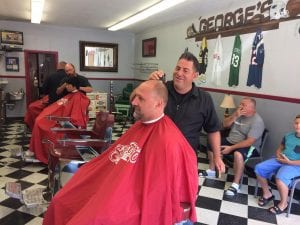
George’s Barber Shop in Saugus, Massachusetts, the oldest barber shop in the country. Photo by Wicked Local/Saugus Advertiser.
Moriello said their customers range from toddlers to seniors.
“We have 1-year-olds coming in for their first haircuts. We have 91-year-olds and everybody in between,” he said.
Moriello noted at the time that he has two barbers who were 22 years old and another one who was 84. He was 46, so he fell in between.
He said George’s Barber Shop has succeeded because it doesn’t specialize in any one age demographic or in cutting hair in any one style.
“You can’t cater to just one group,” he said.
The barber shop struggled during the COVID-19 pandemic. It was closed for 3 months and then had to deal with the fact that people weren’t going out much.
The disease also struck the shop personally when one of their barbers contracted COVID-19 outside of work and died in spring 2021.
“That hit us hard,” said Moriello. “We lost a great member of our team and a great friend.”
Moriello noticed business starting to return as the pandemic began to fade.
Seniors who had been vaccinated were coming in for their first haircut in quite a while. In addition, children returned to school classrooms and need their hair trimmed.
“It’s starting look up,” Moriello said at the time.
Moriello was born and raised in Saugus, a town that now has 28,000 residents. He says he likes the heritage, history and location of town. It’s a small community but only 10 minutes from Boston.
He says Saugus is a “crazy sports town” with people rooting Boston area teams and attending their local high school’s sporting events. He has coached his two sons’ youth sports teams.
“Sports are big in town here,” he said.
——————————————
There’s an old rhyme that has stuck with the town that’s next to Saugus.
“Lynn, Lynn, city of sin. You’ll never come out the way you went in.”
It seems like a bit of an unfair moniker for a community with a varied history of shoe making, jet engines and the Christian Science Monitor movement.
Lynn was established in 1629, just nine years after the Pilgrims landed at Plymouth Rock, by Salem residents who were looking for greener pastures.
Those transplants wasted no time setting up tanneries and shoe manufacturing factories, the first one revving up in 1635. The industry lasted here for almost 350 years.
During the Revolutionary War, local shoe makers provided boots worn by Continental Army soldiers.
By 1795, the city’s factories were producing 170,000 pairs of shoes by hand per year.
In the 1800s, the shoe industry was bolstered by the efforts of Ebineezer Breed, who convinced Congress to slap a protective tariff on shoes made in Lynn.
By the early 1900s, Lynn was the world leader in shoe manufacturing with 234 factories producing more than 1 million pairs of shoes per day. The high level was due in part to a mechanization process invented by African-American immigrant Jan Matzeliger.
From 1924 to 1974, the Lynn Independent Industry Shoemaking School taught people this mechanization process.
The shoe industry faded as foreign competitors took over the landscape. The last factory in Lynn closed in 1981.
Fortunately for the city, there were other industries that helped prop up the economy.
One was transportation.
In 1836, there were 23 stage coaches that left Lynn daily, headed for Boston. The first railroad arrived in 1837 and telegraph service began in 1858.
The transports led to beach resort cottages being built in the mid-1800s. Some are still standing alongside the upper income homes of the Diamond Heights District.
In the 1880s, electricity service was established in Lynn, a modern convenience that helped the shoe industry. The Thomson-Houston Electric Company provided most of the power. In 1892, it merged with Edison Electric Company of Schenectady, New York, and became General Electric.
The two original GE factories were established in Lynn and Schenectady. They manufactured arc lights, motors and meters.
The Lynn plant eventually began specializing in aircraft engines. It built them for the military during World War Two. In fact, the first jet engine aircraft was put together here in 1942.
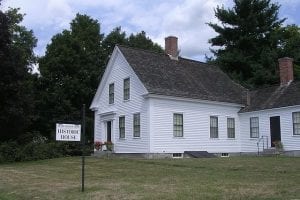
The Mary Baker Eddy Historic House in Lynn, Massachusetts. Photo by Wikipedia.
Today, the General Electric Aviation River Works plant in Lynn has been focused on helicopter engines in recent years.
The manufacturing industry brought in a wave of immigrants. Between 1860 and 1910, the city’s population grew by 450 percent.
The city also developed a reputation for crime and vice, which led to the famous rhyme.
In the early 2000s, Lynn has tried to rebuild its downtown economy through arts, culture and entertainment. Former industrial sites were transformed into lofts. Historic homes were renovated. Plans are being drawn up for several large-scale housing projects near the waterfront.
There are concerns all this redevelopment is causing gentrification.
Today, the city’s population has grown to more than 100,000 people. Its ethnic mix is listed as 43 percent Hispanic or Latino, 35 percent white and 13 percent Black. The median annual household income is $70,000 and the poverty rate is 14 percent. A home costs an average of about $520,000.
The city also has a sizable LGBTQ population.
A 2013 story detailed how the gay community was flocking to Lynn due to its tolerance, affordable housing and available transit to Boston and Cambridge.
A real estate website for gay homebuyers describes Lynn as “historic, hip oceanside town” that is a “picturesque place to live.”
The Lynn Community Health Center provides comprehensive healthcare services to the LGBTQ community. There’s also a number of social organizations that provide programs.
Before we go, there are two historical elements to Lynn.
The first is the town was the home of abolitionist Frederick Douglass and his family from 1841 to 1848. Douglass wrote his most famous book, “Narrative of the Life of Frederick Douglass: An American Slave,” while he lived here.
The second happened in 1886 when Mary Baker Eddy slipped on some ice at a street corner in town. The fall in Lynn is credited with starting the Christian Science religion. Eddy was in critical condition with internal injuries but pulled through. The accident prompted her to start a movement that combined Christianity with the art of healing.
By the time of Eddy’s death in 1910, there were 11,000 Christian Science congregations in North and South America. Women held the prominent missionary role in 60 percent of them. Eddy also founded her organization’s well-known publication, the Christian Science Monitor.
There’s a plaque at the fateful corner commemorating Eddy’s fall. There’s also the Mary Baker Eddy Historic House, the home where Eddy lived from 1875 to 1882.
The Season of the Witch
To say things were a bit hysterical in Salem, Massachusetts, in 1692 would be somewhat of an understatement.
This community of 45,000 people located just 12 miles northeast of Lynn is infamous for what happened here to 20 people accused of witchcraft during a three-month period in 1692.
The town had been founded only 66 years earlier in 1626 by fishermen. They named the town either after the word “shalom,” the Hebrew word for “peace,” or it was a shortened version of Jerusalem, which means the “city of peace.”
The city was anything but peaceful during the early months of 1692.
The Puritans had moved into the region and enacted strict laws and harsh punishments.
The hysteria started after two young girls began acting strange and blamed supernatural forces. The girls’ accusations turned into suspicions that some women in town had been converted into witches.
Nearly 150 men, women and children were arrested. Most were given two options. They could confess to their witchcraft or be executed. Many confessed and even named others, but 19 of the women and men who didn’t confess were hanged. One 71-year-old man who was accused was executed by being pressed to death by stones for failing to enter a plea at his trial. Four other accused witches died while being held in dungeon-like prisons.
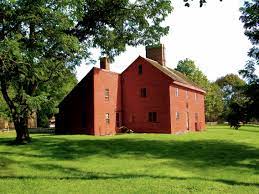
The Rebecca Nurse Homestead in Salem, Massachusetts, the home of my great aunt and her family. Photo by Wikipedia.
In October, the governor disbanded the court that was trying the accused witches. In 1693, he pardoned those who had previously been convicted.
Two of the women who were hanged were Rebecca Nurse and her sister, Mary Towne Easty. Nurse was 71 when she died, the oldest of the victims. She is a central character in Arthur Miller’s play “The Crucible.”
Nurse and Easty are also my ancestors. They were the daughter of my 9th great grandfather, William Towne and the sisters of my 8th great grandfather, Joseph Towne Sr. That makes them great aunts.
The 27-acre Rebecca Nurse Homestead, which was built before 1700, is now a museum just outside Salem in town of Danvers. It’s the only home of an executed person open to the public.
My great aunt’s family lived there from 1678 to 1798. Nurse’s great grandson, Francis Nurse, marched from the home to the Battle of Lexington and Concord in 1775.
There is a Nurse Family Cemetery on the site. Legend has it that Nurse’s husband and son secretly buried her there after she was hanged. There is a memorial to her in the family graveyard.
During a visit to the homestead in July 2023, I spoke with Lisa Trask, a docent at the museum and a direct descendant of Easty. That makes her a distant cousin with Aunt Rebecca as a common ancestor.
Trask said the homestead gets an average of 20 to 30 people visiting a day. Many are descendants while others are simply interested in the history.
She said the history of the executions are recounted in a somber way.
“There we take them seriously,” she told 60 Days USA. ‘We examine what happened and what the people went through.”
Trask adds there are lessons to be learned.
“We hope that people come away with a sense of the unfortunate thing that happened here and learn from it so it won’t ever happen again,” she said.
The home is not the only reminder in the Salem area of the witch trials.
There is a memorial at Proctor’s Ledge, where the hangings took place, to reflect and remember those who were killed. There is also the Witch Trials Memorial with three walls of granite and inscriptions of the hanging victims’ protests of innocence.
In the downtown area, there are witch-related sites focused on tourists.
The Salem Witch Museum contains 13 life-sized stage sets that reenact the 1692 trials. It also has an exhibit on the history of witches in our culture.
The Witch Dungeon Museum also provides live re-enactments of the trials as well as a replica of a dungeon.
There’s even a statue of Elizabeth Montgomery, the actress who played Samantha on the television show “Bewitched.” It’s located at one end of the Essex Street Pedestrian Mall. The show filmed part of its 1970 season in Salem. The statue was unveiled in 2005.
The 1993 movie “Hocus Pocus,” starring Bette Midler and Sarah Jessica Parker, was also partially filmed in Salem.
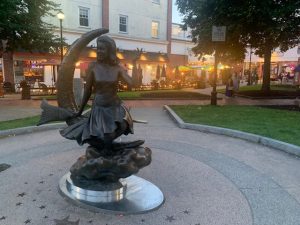
The Elizabeth Montgomery “Bewitched” statue in the Essex Street mall in Salem, Massachusetts
The word “witch” appears all over town. There is a Witch Way as well as a Witchcraft Heights Elementary School. The Salem High athletic teams are known as “The Witches.” That’s in addition to the police car logos as well as stores that sell witch-related souvenirs.
During a typical year, these sites help bring in 1 million tourists to Salem, including 250,000 people during the Halloween season.
Kate Fox, who was the executive director of Destination Salem, told 60 Days USA in spring 2021 that the witch trials do make her city a “unique destination.”
She said that many visitors are fascinated by the topic of the 1692 trials, but she noted there is also a lot to learn from them.
Changes in our justice system were made after the 20 executions.
“The idea of innocent until proven guilty was born from the Salem witch trials,” she said.
Fox added there is a connection between those trials and other hysterias that have gripped the United States over the centuries.
There was the tuberculosis scare in Rhode Island.
The Japanese internment camps during World War Two are another example.
There was also a “pink” hysteria in an Idaho town in the 1950s we will visit near the end of our journey where men were accused by a frightful community of being gay.
Also in the 1950s, there was the “Red Scare,” led by Senator Joe McCarthy where people working in the State Department, Hollywood and other places were accused of being communists.
In most recent times, there have been the treatment involving gays during the 1980s AIDS crisis, Muslim Americans after the September 11, 2001, terrorist attacks and the assaults of Asian Americans related to the spread of COVID-19.
“Social witch hunts continue to happen,” noted Fox, who in June 2023 became the tourism chief for the state of Massachusetts.
She said in 2021 that Salem does get some pushback from religious folks who find the witch-related tourism to be immoral, but Fox said that is a small percentage of the feedback they receive.
She said the community hopes people pick up some history lessons when they visit.
“We hope they get a little education with their entertainment,” she said.
Fox said the most popular tourist attraction in town is probably the witch museum, but visitors also clamor to take their picture at the Elizabeth Montgomery statue.
“Everybody loves her,” she said.
Salem’s history isn’t all about witches.
The city is considered the birthplace of the U.S. Army National Guard. It was created during a “muster” on the Salem Common by colonial militia members.
During the Revolutionary War and the War of 1812, Salem was a center for privateering, where private ship owners would get Letters of Marque and try to capture enemy ships. During the Revolutionary War, these privateers sunk or captured 445 British vessels.
After the war, the privateers used their ships to conduct trade with Asian and Pacific Islands. One came back with the first imported pepper into the United States.
The seaport trade expanded in later years with exports of codfish to Europe as well as sugar and molasses imports from the West Indies. Tea was also brought in from China.
In 1790, Salem was the nation’s sixth most populous city and the wealthiest per capita. The city was also home to the country’s first millionaires.
Shipping declined in the 1800s as the harbors in New York and Boston grew, so Salem turned to manufacturing that centered on tanning, shoe leather and cotton.
Salem was also home to author Nathaniel Hawthorne.
The Salem native worked at the city’s port from 1846 to 1849. After that stint, he wrote “The Scarlett Letter.” It was not a popular book in Salem, but it was well received nationwide, becoming the first mass produced book in U.S. history.
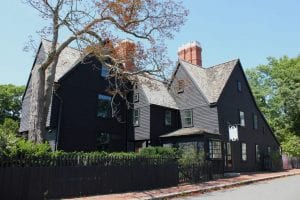
The House of the Seven Gables in Salem, Massachusetts. Photo by Lost New England.
The city is also home to the House of the Seven Gables, which was the inspiration for the Hawthorne novel of the same name. The house was originally built in 1668 for Captain John Turner. Three generations of Turner’s family lived in the home before Hawthorne’s family purchased it.
Fox said she has two favorite spots that are not part of the traditional tourist agenda.
One is the Phillips House on historic Chestnut Street, the first planned street in the United States. It was built exactly 60 feet wide, so horse carts could turn around.
The other is Count Orlok’s Nightmare Gallery. The museum features villains and monsters from horror films.
“It highlights the things we love to be afraid of in cinema,” Fox said.
Salem is trying to diverse its economy.
A waterfront redevelopment started in 2006 with $1 million in state funds. In 2018, the Salem Harbor Footprint 674-megawatt natural gas power plant opened on the site of an old coal-fired plant.
Kim Driscoll, who arrived in Salem in 1986 as a college student has stayed and led her community. In November 2021, she was easily re-elected to a fifth term. In November 2022, Driscoll was elected as the state’s lieutenant governor.
Fox said many people visit Salem, fall in love with the area and then move here. That’s what Fox did in 1998.
Fox said Salem is a mix of long-time residents along with college students and attorneys who work at the courts in town.
She said the town has a beautiful harbor and coastline with terrific weather in the summer. There’s nothing, she said, like sitting along the water’s edge with a cold beer and watching the boats sail by.
“I love Salem. It’s unique. It’s walkable. It has so many great attributes,” she said.
A good place to end Day 28.
Tomorrow, we’ll leave Massachusetts and cruise the Maine coastline to check out a presidential seaside town, the home of a famous Civil War era author and the headquarters of one of the country’s more popular outdoor clothing lines.


